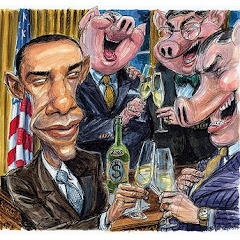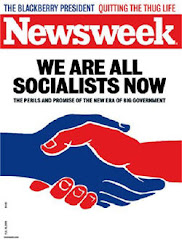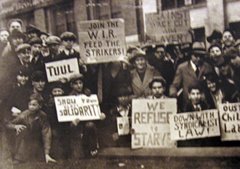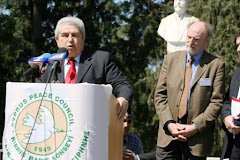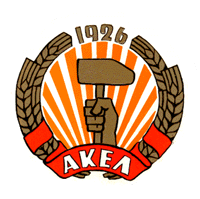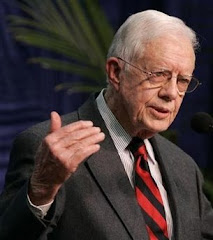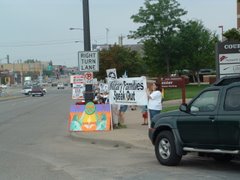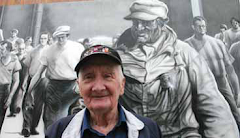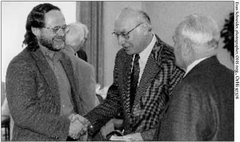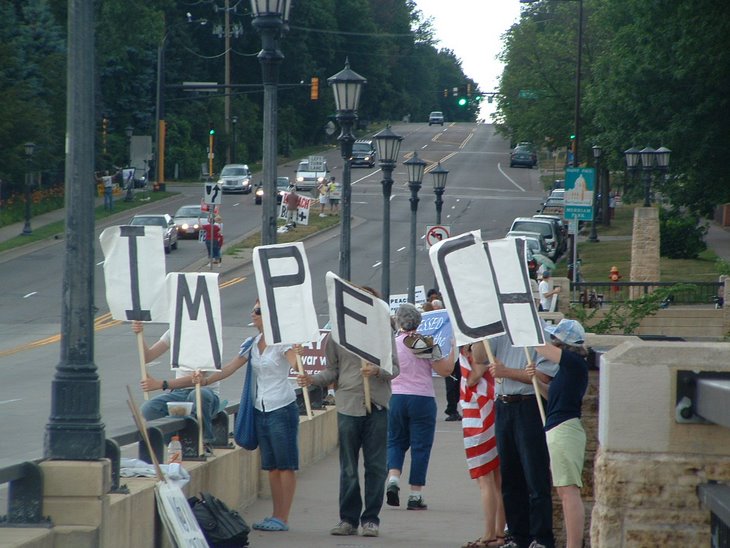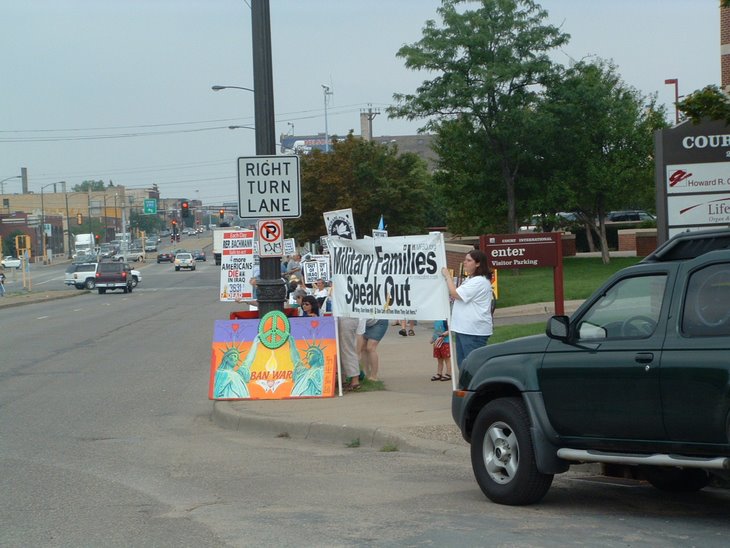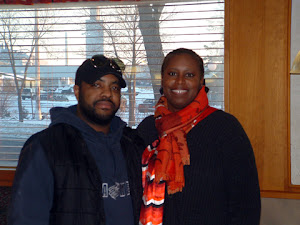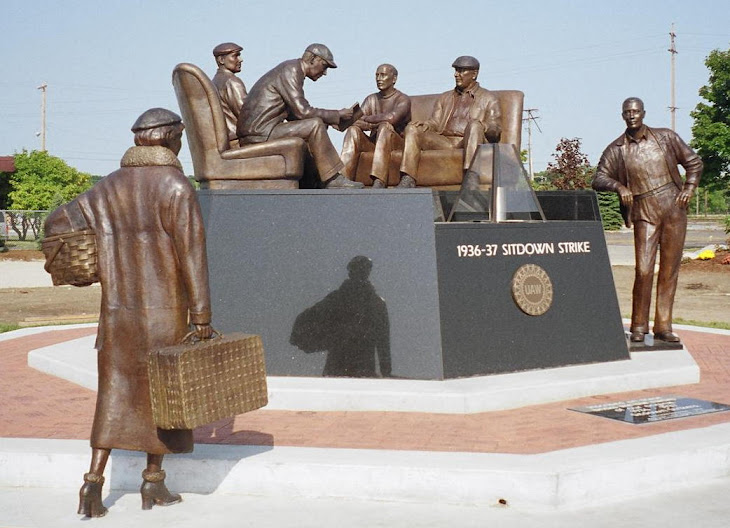Following the article I have posted my comments and thinking on this issue.
I should have mentioned the signs in the photograph in my comments… “Save the middle class” carried by workers decked out in flags as U.S. imperialism is murdering people all over the world. David Bacon should have started his analysis with this scenario of workers not even understanding what “class” they are in.
Yours in struggle and solidarity,
Alan L. Maki
Link:
Can Labor Get Out of This Mess? (Part One)
Wednesday
July 29
9:01 am
 Union members protest outside U.S. Bankruptcy Court on June 30, 2009 in New York City. General Motors appeared in the court to seek approval of a plan to sell its assets under federal reorganization.
Union members protest outside U.S. Bankruptcy Court on June 30, 2009 in New York City. General Motors appeared in the court to seek approval of a plan to sell its assets under federal reorganization.For anyone who loves the labor movement, it’s not unreasonable today to ask whether we’ve lost our way. California’s huge healthcare local is in trusteeship, its leading organizing drive in a shambles. SEIU’s international is at war with its own members, and now with UNITE HERE, whose merger of garment and hotel workers is unraveling.
In 1995, following the upsurge that elected John Sweeney president of the AFL-CIO, the service and hotel workers seemed two of the unions best able to organize new members. Their high-profile campaigns, like Justice for Janitors and Hotel Workers Rising, were held out as models. Today they’re in jeopardy.
This conflict has endangered our high hopes for labor law reform, and beyond that for an economic recovery with real jobs programs, fair trade instead of free trade, universal healthcare, and immigration reform that gives workers rights instead of raids. The ability of unions to grow in size and political power is on the line.
Today only 12 percent of workers belong to unions, and less in the private sector—the lowest level of organization since the years before the great longshore strike of 1934. And falling numbers aren’t the whole story.
Some labor leaders now say that only huge deals at the top, far from the control of rank-and-file workers, can bring in new members on the scale we need. To make those deals attractive to employers, they argue, unions have to be willing to make deep concessions in wages and rights, and in our political demands—on everything from single-payer healthcare to immigration reform.
We need some better ideas about how unions should organize—we need to rethink even what a union actually is.
Part of our difficulty is that our labor movement, and workers themselves, think about their interests in relatively narrow terms. By comparison with workers in South Africa, El Salvador, or even Mexico and Canada, we are very conservative and reluctant to see the root of our problems in the system itself, or to talk openly about the need to change it drastically. It is more important than ever that workers see their class interest. But what is that interest? And how should we defend it?
Our labor movement has resources and wealth that are enormous by comparison with most unions around the world. But what good is it if we don’t at least use it effectively to defend ourselves, or if it even becomes a brake on our willingness to take risks, like those French workers who lock their bosses in their offices, or Mexican workers, who facing the declaration of their strike in Cananea as illegal, have defied and fought it for the last two years?
Over the last four decades, corporations have built an international system of production and distribution that links together the workers of many countries, but in which workers have no control over the expropriation and distribution of the wealth they create. Further, this system has forced devastating and permanent unemployment on entire generations of U.S. workers, especially in African-American and Chicano neighborhoods.
Meanwhile, neo-liberal economic policies displace communities in developing countries, creating a reserve labor force of hundreds of millions, migrating both within and across borders, desperate for work.
Employers have always used the migration of people to this country as a labor supply system. Today that use is more overt than ever. NAFTA alone created such displacement in Mexico that over 6 million Mexican workers and farmers have come here looking for a way to guarantee their families’ survival. Our immigration policy is then used as the means to criminalize not just their labor (by making it a federal crime for a worker without papers to have a job) but the very status of millions of people, who, like everyone else, have no alternative but to work.
Large corporations, with allies in the administration, among lobbying groups in Washington, and even in our labor movement itself, are now proposing changes that would substitute contract labor programs for family reunification, force all workers to carry a national ID in order to work, and require the firing of millions of workers who can’t get the required “work authorization.”
Our labor movement was organized by immigrants and their children—by people who came from somewhere else. But our unions have been organized in a working class deeply divided by race and nationality. The key issue confronting our labor movement for the last 180 years is inclusion or exclusion.
Today, undocumented immigrants ask: Will the unions I paid my dues to defend me when the government tells my boss to fire me because I don’t have papers? It’s not an abstract question. Two-hundred and fifty-four workers at Overhill Farms, fired two months ago in Los Angeles, are asking that question to UFCW Local 770 today.
For unions and workers to survive in this environment, they must demand increasingly radical reforms. Accepting the limits of “what’s politically possible” as defined by Washington insiders, whether they seek to prevent discussion of single-payer or the repeal of employer sanctions, is a recipe for disaster. We cannot defend ourselves if our only goal is to “be at the table.”
Each month for almost a year, over half a million people have lost their jobs. Meanwhile, banks have been showered with hundreds of millions of dollars to keep them afloat, while working families can’t get their loans renegotiated so they can stay in their homes. Yet there has been no national demonstration called by either labor federation, demanding a direct federal jobs program or redirecting the bailout to workers instead of the wealthy.
[Editor’s note: Part 2 of “Can Labor Get Out of This Mess?” will appear on this site next Tuesday, August 4.)
Posted by David Bacon •
MORE BY DAVID BACON
• Can Labor Get Out of This Mess? (Part One)
Comments
alanmaki 1 Aug 2009
In fact, the unions have been collaborating with employers to oppress and exploit workers in this country. Many union contracts don’t even provide a living wage… about 40% of the present union contracts are nothing but poverty wage contracts.
Over two-million people are employed in the Indian Gaming Industry now employing over two-million workers at over 350 casinos spread out across this country working in smoke-filled casinos at poverty wages without any rights under state, federal, tribal or international labor laws or standards. These casinos are largely built under terms of sweetheart contracts by union members who pay dues even though they are not protected by union contracts and their pension funds are financing the construction of these casinos. The “Compacts” creating this “unique” Indian Gaming Industry were created and crafted with the support of the unions and their Democratic Party partners without a whimper of protest from the American Civil Liberties Union.
Workers don’t want to join existing unions because they view them as corrupt, which they are; and just another of many institutions out to profit through dues collection.
Most unions have a difficult time even turning out a constitutionally mandated quorum for regular meetings. And workers who do bring their problems to union meetings and the union staffs are treated as “trouble-makers.”
The unions have refused to fight for implementation of affirmative action; they have refused to initiate a real struggle for socialized health care and they have done a terrible job educating workers against racism and how imperialism is destroying lives of workers here at home while killing workers abroad.
Today’s unions are operating under the influence and dominance of the capitalist ideology of “pragmatism” rather than class struggle.
David Bacon is refusing to address the real problems in unions here… perhaps he should get a job in a loud, noisy, smoke-filled casino where he would be forced to work without any rights and go to an AFL-CIO or CTW union for help… then he will find out what is really wrong in today’s “labor movement.”
Without a strong “left” and a strong Communist Party among the rank and file, the labor movement will continue to flounder as Barack Obama carries out Wall Street’s agenda of attacking labor at home and workers abroad in quest of greater profits while making the working class pay for the problems workers had no part in creating.
Alan L. Maki
Director of Organizing,
Midwest Casino Workers Organizing Council
amaki000@centurytel.net
http://thepodunkblog.blogspot.com/
I added a further comment...
alanmaki
1 Aug 2009
6:56 am
I forgot to mention… check out the photograph.
Because the UAW has left the education of auto workers to the Big Three, workers don’t even know what class they are in… check the photo out… these workers are demanding that the “middle class” be saved when they should be concerned about their own class: the working class.
Alan L. Maki






























